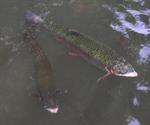Aquaculture
Aquaculture is a boom industry globally; driven by increased demand for seafood, and reducing natural resources.
 Many of the world's rivers, oceans and lakes have been over fished, and current predictions indicate that most of the fish and crustaceans we eat will eventually need to be farmed, rather than coming from natural resources.
Many of the world's rivers, oceans and lakes have been over fished, and current predictions indicate that most of the fish and crustaceans we eat will eventually need to be farmed, rather than coming from natural resources.
In 2006, the Food and Agriculture Organization of the United Nations (FAO) reported that:
“Aquaculture, probably the fastest growing food-producing sector, now accounts for almost 50 percent of the world’s food fish and is perceived as having the greatest potential to meet the growing demand for aquatic food. Given the projected population growth over the next two decades, it is estimated that at least an additional 40 million tons of aquatic food will be required by 2030 to maintain the current per capita consumption”.
The world population has outpaced any material changes to our agricultural land. We do not know if the population will continue to grow, but we do need to look at other methods of producing food that are not so land intensive. Commercial aquaculture is one such method.
DeLoitte’s state that since the 1980s, world aquaculture production has increased from 7% to 40% of global fisheries making aquaculture an appealing and attractive prospect when considered in relation to traditional agricultural methods.
A report by the State of Fisheries and Aquaculture (SOFIA) in the World 2018 reported an annual growth rate between 2001 and 2016 of 5.8%,whilst indicating that aquaculture continues to grow faster than other major food production sectors. In 2016, aquaculture accounted for 53% of the fish production for human consumption.
What is involved?
There are three main requirements for aquaculture:
- Contained area (e.g. ponds, caged areas natural bodies of water, tanks). If ponds are to be built, not all land can be used for ponds. This land should preferably have a high clay content to hold the water efficiently.
- Water - a reliable source of good quality water is needed ‑ this may be from storage dam, river or bore hole.
- Food - an inexpensive source of fish feed is a must. This can range from plant growth in a pond to fishmeal products produced on the same farm or bought in as rough or processed feed. Fish meal made from fish flour from low quality fish is used at the moment to feed higher quality fish. With the problem of dwindling fisheries, fish flour has become scarcer and more expensive, facing the aquaculture business with the need to look for alternative sources of proteins for fish feeding. Soy may be another source.
Advantages to aquaculture are:
- We have the knowledge to produce more animal protein per hectare, with aquaculture; than most other kinds of livestock farming.
- Aquaculture can make good use of marginal land that is unsuitable for other farming.
- Fish contain a greater percentage of edible flesh than most other animals.
- Livestock can live off food generally inedible to man.
- Fish require less feed to produce this flesh than animals like cattle and sheep. Feed conversion efficiency is partly because most fish are cold blooded and do not need to use energy to keep warm. This energy remains stored as flesh and fat. Also, the buoyancy of the water habitat in which fish live means they use less energy to move.
Disadvantages include:
- Commercial production of fish requires high quality, high protein food. The proportion of protein in most livestock diets is lower than that required for fish, and many are adapted to extract the protein from amino acids in the plants they feed on.
- Setting up an intensive fish farm is far more expensive than enclosing land with conventional or electric fencing and establishing grazing for livestock.
- Aquatic environments need a very constant environment and if things like water quality or pH change; fish become susceptible to illness - diseases, parasites and predators. They can tolerate only small changes in their environment and these must not be too sudden or drastic.
- Aquaculture requires a clean supply of water, free of excess nutrients or pollutants.
Learn More About Aquaculture with ACS
Whether you are looking to diversify your existing business, or developing your career we can help. ACS have courses in Aquaculture and Fish Care And Culture. These can be studied on their own or as part of more in-depth qualifications in farming and farm management.
If you are thinking of studying, why not get in touch with us today? Submit your questions to our specialist Agriculture tutors - tell them your goals and discuss different study options with them. Or, phone us on (UK) 01384 442752 or (International) +44 (0) 1384 442752.
[14/03/2025 22:48:07]
More from ACS
Directory to dozens of courses include short courses, certificates and diplomas.